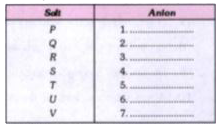Identify the salt Q from the observation
Salt Q is white in colour. On strong heating, it produces buff yellow residue and liberates reddish brown gas. Solution of salt Q produces chalky white insoluble precipitate with excess of ammonium hydroxide.
The salt Q is lead nitrate
When reacted with ammonium hydroxide solution it gives a chalky white precipitate of lead hydroxide :
Topper's Solved these Questions
- BOOK - ICSECHAPTER - SAMPLE PAPER 2020EXERCISE - SECTION-II (40 Marks) Attempt any four questions from this Section47videos
SAMPLE PAPER 2020
- BOOK - ICSECHAPTER - SAMPLE PAPER 2019EXERCISE - SECTION - I1videos
SAMPLE PAPER 2019
- BOOK - ICSECHAPTER - SAMPLE PAPER 3 EXERCISE - MULTIPLE CHOICE QUESTION40videos
SAMPLE PAPER 3
Similar Questions
Identify the salt R from the observation
Salt R is black in colour. On reacting with concentrated HCl, it liberates a pungent greenish yellow gas which turns moist starch iodide paper blue black.View SolutionIdentify the salts P & Q from the observations given below: i] On performing the flame test salt P produces a lilac coloured flame & its solution gives a white precipitate with silver nitrate solution, which is soluble in ammonium hydroxide solution. ii] When dilute HCl is added to a salt Q, a brisk effervescence is produced and the gas turns lime water milky. When NH4OH solution is added to the above mixture [after adding dilute HCI], it produces a white precipitate which is soluble in excess NH4OH solution.
View SolutionIdentify the salts P from the observations given below:
On performing the flame test salt P produces a lilac coloured flame and its solution gives a white precipitate with silver nitrate solution, which is soluble in Ammonium hydroxide solution.View SolutionIdentify the salts P, Q, R from the observation
Salt P has light bluish green colour. On heating, it produces a black coloured residue. Salt P produces brisk effervescence with dil. HCl and the gas evolved turns lime water milky, but no action with acidified potassium dichromate solution.View SolutionIdentify the acid which matches the following description
The acid on mixing with silver nitrate solution produces a white precipitate which is soluble in excess ammonium hydroxide.View SolutionIdentify the anion present in the following compounds:
i] Compound X on heating with copper turnings & conc. sulphuric acid liberates a reddish brown gas.
ii] When a solution of compound Y is treated with silver nitrate solution a white precipitate is obtained which is soluble in excess of ammonium hydroxide solution.
iii] Compound Z which on reacting with dilute sulphuric acid liberates a gas which turns lime water milky, but the gas has no effect on acidified potassium dichromate solution.
iv] Compound L on reacting with barium chloride solution gives a white precipitate insoluble in dilute hydrochloric acid or dilute nitric acid.View SolutionIdentify the acid which matches the following description (i) to (v):
The acid on mixing with silver nitrate solution produces a white precipitate which is soluble in excess ammonium hydroxide.View SolutionThe questions below refers to the following salt solutions listed A to F:
A: Copper nitrate, B: Iron [II] sulphate, C: Iron [III] chloride, D: Lead nitrate, E: Magnesium sulphate, F: Zinc, chloride.
Which solution gives a white precipitate with excess ammonium hydroxide solution.View SolutionThe question refer to the following salt solutions listed A to F
(A] Copper nitrate [B] Iron sulphate
[C] Iron (III) chloride [D] Lead nitrate
[E] Magnesium sulphate [F] Zinc chloride
Which solution gives a white precipitate with excess ammonium hydroxide ?View SolutionSalts P, Q,R,S,T,U and V undergo reactions (i) to (vii) respectively. Identify the cation present in these salts on the basis of these reactions. Tabulate your answer in the formate given below.
(i) When the salt Pis heated with sodium hydroxide solution a vigorous reaction takes place and a colourless gas is evolved with a pungent and suffocating smell that brings tears in our eyes. The evolved gas gives dense white fumes with a moist glass rod depped with hydrochloric acid.
(ii) Addition of sodium hydroxide solution to a solution of salt Q gives a thick white precipitae which is soluble in excess of sodium hydroxide solution to form a clear solution.
(iii) Addition of ammonium hydroxide solution to a solution of salt R gives a dark blue precipitate which is soluble is excess of ammonium hydroxide solution to form an intense deep blue solution.
(iv) Addition of ammonium hydroxide solution to a solution of 5 gives a dirty green [bottle green] precipitate which is insoluble even in the excess of ammonium hydroxide solution.
(v) Addition of ammonium hydroxide solution to a solution of T gives a reddish brown (rust precipitate] precipitate which is insoluble even in the excess of ammonium hydroxide solution.
(vi) Addition of ammonium hydroxide solution to a solution of V gives a geletaneous white precipitate which is soluble in excess of ammonium hydroxide solution to form a clear solution.
(vii) Addition of ammonium hydroxide solution to a solution of V gives no precipitate but it gives a chalky white precipitate with sodium hydroxide solution which is insoluble even in the excess of sodium hydroxide solution.
 View Solution
View Solution

